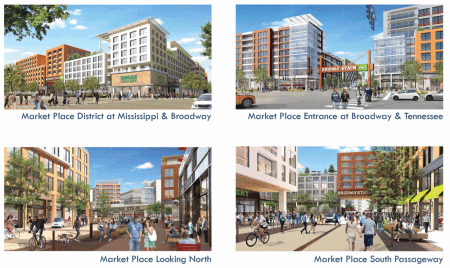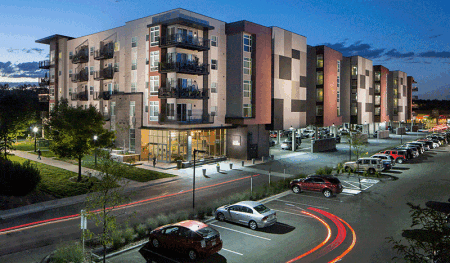As the Denver metropolitan area has topped 3 million residents, potentially accelerating toward 4 million, a sustainable land use template for future mobility and economic, social, and environmental health is emerging within the framework of the 122-mile (196 km), 57-station FasTracks rail and bus rapid transit network, which includes expansion with five new transit lines this year. ULI Colorado’s TOD Marketplace event, held in Denver in early November, attracted participants from Colorado and beyond to tour various transit-oriented development (TOD) sites and hear about both lessons learned and future trends.
Kent Larson, an architect and co-director of the City Science Initiative for the Media Lab at the MIT School of Architecture and Planning, opened the event with the TOD and Cities of the Future general session.Larson discussed innovative technology and planning tools the lab is developing to help cities quickly visualize a radically different future. He illustrated with Media Lab projects focused on “evidence-based modeling.” In one of the lab’s CityScope projects, researchers created interactive three-dimensional maps for a community engagement process in Hamburg, Germany, to plan for equitable distribution of housing and services for some 80,000 migrants. The researchers used Lego blocks to represent units of data, such as revenue, activities, and vehicles, and created city models with Lego blocks color-coded for housing, retail, and other uses. “We found it was a good way to rapidly map a city, and then found we could create an augmented-reality interface, like an Avatar holo table” for architecture and planning.
Upcoming Events With ULI Colorado
In transit, said Larson, “the shared autonomous vehicle is the future.” Partnering with Japanese auto maker DENSO, the lab is working on a 2.0 version of a low-cost, three-wheeled, autonomous “persuasive electric vehicle” (PEV) that can move people and goods in bike lanes. “The message is these [PEVs] aren’t scary. We designed them a little like a baby carriage, so they’re not threatening.”
The shared autonomous vehicle was a key topic at a panel on High Tech and Disruptive Technologies. Rutt Bridges, author of Driverless Car Revolution: Buy Mobility, Not Metal, said that commercial autonomous cars would likely arrive in the United States by 2020 and increase rapidly as the cost of batteries and technology declines. “Low cost is most likely to drive consumers,” he said. “By 2025, you’ll be able to travel for 30 cents per mile for four seats and a child seat, bike rack, storage, plus someone driving and managing the fleet.” An alternative to expanding highways, he said, is “public transit 2.0: free driverless carpools.” Federal subsidies average 95 cents per mile for buses, he said, and by 2025, a three-person driverless carpool will cost only 10 cents per passenger mile. Plus, he said, fleets of these “platooning” vehicles can increase vehicles per lane-mile and conquer congestion.

An approved plan for redeveloping the former Gates Rubber Co. property, one of the largest transit-oriented development infill sites in the Denver market. The plan includes four subareas—the station, market-place mixed-use, residential, and parkland—with connections across the rail corridor and the South Platte River and into surrounding neighborhoods. (Matrix Design Group)
Speaking at another session, Laura Aldrete, principal associate planner of Matrix Design Group, an urban design firm involved in several TOD sites, said that TOD planning requires making “a partnership with your transit agency early and often” and addressing “longstanding issues within the community,” such as connectivity. The firm’s approved plan for redeveloping one of Denver’s largest TOD infill sites, the 41-acre former Gates Rubber Company site at the I-25 and Broadway light-rail station, includes connections over rail lines, the South Platte River, and with adjacent neighborhoods.
Maureen Phair, executive director of the Arvada Urban Renewal Authority (AURA), said that the city of Arvada, Colorado, worked with Denver’s Regional Transit District to turn a planned nine-acre (3.6 ha), 400-vehicle surface parking lot next to the new Olde Town Arvada rail station into a 600-car shared parking garage for transit riders and downtown patrons, freeing up the rest of the site for 200 units of housing and 40,000 square feet (3,700 sq m) of commercial development. At another site within the TOD urban renewal area, on a heavily trafficked arterial, AURA rejected a plan for garden apartments for a much denser podium and elevator-served building. “You can’t get rents to rationalize that” in the suburbs, she said, so the city discounted the land, created a tax increment financing district, waived development fees, and rebated use tax for the 153-unit Park Place Olde Town, now open and 100 percent leased.
Denver’s TOD history began in 1867, when local business leaders raised $1 million to build a rail spur to the transcontinental railroad, said Kelly Brough, president and CEO of the Denver Metro Chamber of Commerce, and moderator of the Opportunity Corridors panel. More recently, FasTracks transit corridors “have made all the difference as to where and who we are.” Brough added that collaboration and “patience,” which she called “the most underrated quality of TOD development, considering the length of time and challenges you face,” also contributed.
On FasTrack’s fast-growing Southeast Corridor, “capacity for office is tied to rail” to mitigate the impact of traffic because I-25 cannot handle much additional growth, said Dan Guimond, principal of Economic & Planning Systems in Denver. The light-rail line, opened in 2006, has brought higher density and more mixed-use development to the established suburban business corridor. Some 77 percent of all Class A office space and 66 percent of all office space on the corridor is now located within one-half mile (0.8 km) of a transit station. The line will be expanded from six to nine stops by 2019.
Parking is “a tricky subject, and subject to change over time,” said Keith Simon, executive vice president of Coventry Development Corporation, master developer of RidgeGate, a 3,500-acre (1,400 ha) mixed-use community being built in Lone Tree, Colorado, with access to three new light-rail stations. “It’s hard to know the effect of autonomous cars and people commuting by rail.” The finance industry is still looking at four parking spaces per 1,000 square feet (93 sq m) of office space, he said. At RidgeGate, Charles Schwab built a headquarters initially with six spaces per 1,000 square feet of office space, but will be 1,000 spaces short in the next development phase. “People are consuming a lot less square footage of work space, so it’s very challenging.” RidgeGate is planning for less parking in the long term, however, with structured parking featuring flat rather than sloped levels and ramps in the middle to allow for later conversion to other building uses.
“Infrastructure is key,” said Buz Koelbel, president of Koelbel & Co. in Denver and one of the region’s longtime TOD leaders. He said that public/private partnerships surpassed jurisdictions and ideologies as many partners prepared the region for building FasTracks. “We had a vision to put Denver on the map of the world,” said Koelbel. “I used to say light rail will be market driven, but what light rail has done for placemaking and density” has made Denver “a city of the new millennium.”
“It’s time for Denver to show up,” said Kimball Crangle, Colorado market president for Gorman & Co., in a panel on “The NEXT Generation of Urban Infill Developers.” “As a city, we’re gaining global attention and we’re attracting more funding, but we need to show the way in terms of social equity and equal opportunities. We’re a welcoming community and we encourage an entrepreneurial spirit that translates to who you live next to and how we create community. That’s what this next generation has to offer.”
Kathleen McCormick, principal of Fountainhead Communications in Boulder, Colorado, writes frequently about healthy, resilient, and sustainable communities.






